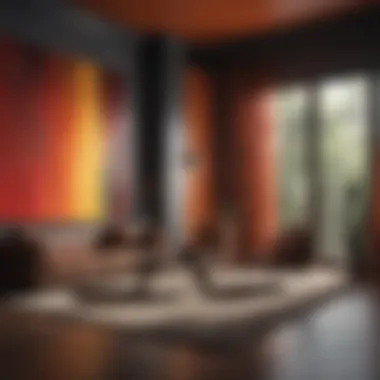Unlocking the Perfect Hue: Tips for Choosing Your Room's Color Scheme


Outdoor Decor Ideas
Exclusive Destinations
Exploring exclusive destinations can spark creativity in choosing the perfect color for your room. Hidden gems off the beaten path may inspire unique and unconventional color choices that reflect a sense of adventure and discovery. Luxury resorts can offer sophisticated color palettes that evoke opulence and elegance, providing inspiration for a lavish room transformation. Private villas in exotic locations showcase customized color schemes that cater to indulgence and relaxation, offering a personalized touch to your interior design. By drawing inspiration from exclusive destinations, you can infuse your room with a sense of luxury and refinement that mirrors the ambiance of upscale retreats.
Home and Interiors
Delving into home and interiors trends is essential when embarking on the journey of selecting a room color. Keeping abreast of interior design trends can steer your color choice towards modern or classic palettes based on current aesthetic preferences. Home organization plays a pivotal role in creating a clutter-free space that allows your chosen color to stand out and make a statement. Exploring smart home innovations can introduce technological elements that interact with color in innovative ways, offering a futuristic approach to room design. By immersing yourself in the world of home and interiors, you can gather valuable insights and inspiration to craft a color scheme that resonates with your personal style and aesthetic vision.
Understanding Color Psychology
Color psychology plays a pivotal role in determining the overall ambiance and aesthetic appeal of a room. Understanding how colors affect mood and perception is crucial when deciding on the perfect paint color for your living space. The right color can evoke emotions, reflect individuality, and set the tone for the entire room's decor. By delving into the intricacies of color psychology, you can create a personalized space that resonates with your personality and style.
Impact of Colors on Mood
Red for Energy and Excitement
Red, a vibrant and dynamic hue, is renowned for its ability to invigorate spaces and promote a sense of energy and excitement. Incorporating red accents or using it as a primary color can stimulate conversation, enhance creativity, and infuse warmth into the room. However, excessive use of red may lead to feelings of agitation or intensity, making it essential to balance this bold hue with more calming shades.
Blue for Calmness and Serenity
Blue, with its tranquil and serene qualities, is perfect for creating a relaxing atmosphere within a room. This color promotes a sense of peace, aids in stress reduction, and fosters a contemplative environment. Whether used as the main color or as an accent, blue exudes sophistication and elegance, making it a popular choice for bedrooms, living rooms, and bathrooms.
Yellow for Cheerfulness and Optimism


Yellow, the color of sunshine and happiness, instills a sense of cheerfulness and optimism into any space. By choosing yellow tones, you can evoke feelings of joy, enhance natural light, and create a welcoming ambiance. However, excessive use of yellow may lead to feelings of unease or overstimulation, making it important to balance this bright hue with neutral tones for a harmonious look.
Color Associations and Symbolism
Cultural Significance of Colors
Colors hold diverse cultural meanings and symbolisms across the globe, influencing perceptions, traditions, and societal norms. Understanding the cultural significance of colors enables you to incorporate elements of heritage, symbolism, and history into your decor choices. Whether drawing inspiration from Eastern mysticism or Western symbolism, cultural colors add depth and richness to your living space, reflecting a fusion of tradition and modernity.
Personal Preferences and Significance
Personal preferences play a crucial role in determining color choices for interior spaces. Your individual inclinations towards certain colors are often interconnected with memories, emotions, and experiences, shaping your personal style and aesthetics. By intertwining your unique preferences with design principles, you can curate a space that not only resonates with your personality but also exudes sophistication and visual appeal.
Assessing Room Size and Layout
When it comes to deciding on the perfect color to paint your room, assessing room size and layout plays a crucial role in achieving an aesthetically pleasing result. Understanding the dynamics of your space, whether it's small or large, can significantly impact the choice of colors. For small rooms, it is essential to opt for light colors as they create an illusion of space, making the room appear larger and more open. Monochromatic schemes, on the other hand, offer cohesion by using varying shades of a single color, providing a sense of unity and sophistication within a confined area. Taking into account these factors ensures that your room's size and layout are optimized to create the desired ambiance.
Choosing Colors for Small Rooms
Light Colors for Space Illusion
Light colors, such as soft pastels and neutrals, are instrumental in creating the perception of a larger space in small rooms. These hues reflect natural light, giving the room an airy and open feel. Additionally, light colors bounce light around the room, eliminating shadows and brightening the space. Their versatility allows for easy coordination with different decor styles, making them a popular choice for small room applications. While light colors can visually expand a room, they might lack warmth and coziness compared to darker shades.
Monochromatic Schemes for Cohesion
Monochromatic schemes involve using varying shades and tones of a single color throughout the room. This approach creates a sense of visual continuity and harmony, making the space feel unified and well put together. By sticking to one color family, monochromatic schemes simplify the choice-making process and ensure a consistent and balanced look. However, it's crucial to play with texture and layering to prevent the room from feeling flat or uninspired. Despite their elegant and sophisticated appeal, monochromatic schemes may lack the diversity and contrast that other color palettes offer.


Optimal Colors for Large Rooms
Dark Colors for Warmth and Intimacy
Introducing dark colors like deep blues, rich greens, or charcoal grays to a large room adds a sense of warmth and intimacy. These hues create a cozy atmosphere, making the space inviting and conducive to relaxation. Dark colors are excellent for large rooms as they help anchor the space and prevent it from feeling overly expansive. However, it's essential to balance dark hues with ample lighting to avoid a cramped or heavy look. While dark colors evoke luxury and sophistication, they can absorb light and make the room feel smaller if not appropriately complemented.
Contrasting Elements for Visual Interest
Incorporating contrasting elements, such as pairing bold colors with neutral tones or mixing textures, adds visual interest and depth to a large room. By juxtaposing colors with varying intensities, you create focal points and highlight architectural features, breaking the monotony of a vast space. Contrasting elements add personality and character to the room, making it visually stimulating and engaging. However, it's crucial to strike a balance between contrasting elements to prevent the room from appearing chaotic or disjointed. While contrast enhances drama and elegance, overdoing it can result in a clash of styles and visual overload.
Considering Natural Light and Artificial Lighting
When you embark on the journey of deciding what color to paint your room, it is imperative to scrutinize the impact of natural light and artificial lighting. Don't underestimate the significance of lighting conditions when it comes to color choices. Natural light streaming through your windows can alter the appearance of colors throughout the day, while artificial lighting can enhance or diminish certain hues. These factors play a crucial role in creating the desired ambiance within your living space. To make a well-informed decision, consider the interplay between light sources and color selections, ensuring a harmonious and visually appealing outcome.
Impact of Light Direction on Colors
North-Facing Rooms and Cool Tones
As you ponder over the nuances of light direction on colors, delve into the realm of North-Facing Rooms and Cool Tones. These rooms receive a cooler quality of light due to their northern orientation, which tends to cast bluish undertones on surfaces. Opting for cool-toned colors such as blues, greens, or purples can counterbalance this effect, creating a soothing and refreshing atmosphere. Embrace the gentle embrace of cool tones in North-Facing Rooms to infuse a sense of tranquility and depth into your living space.
South-Facing Rooms and Warm Tones
In contrast, the sun-soaked allure of South-Facing Rooms beckons for warm tones to amplify their radiance. These rooms bask in a wealth of natural light, inherently uplifting the mood with golden undertones. Opt for warm hues like yellows, oranges, or reds to capitalize on this abundant sunlight, infusing your space with a cozy and inviting aura. Warm tones in South-Facing Rooms evoke a sense of comfort and intimacy, enveloping occupants in a welcoming embrace.
Choosing Light Reflective Colors


Let's immerse ourselves in the realm of choosing light reflective colors, a vital consideration in your color selection journey.
White and Pastels for Brightness
White and pastel shades emerge as champions in the quest for brightness and luminosity. These light reflective colors bounce natural and artificial light off their surfaces, amplifying the perception of spaciousness and airiness in a room. The purity and simplicity of white, coupled with the softness of pastels, create an ethereal ambiance that is both timeless and elegant. Embrace the radiant allure of white and pastels to elevate your space with a sense of lightness and purity.
Mirrored Elements for Light Enhancement
When seeking to enhance the luminosity in your room, consider incorporating mirrored elements into your decor. Mirrors are powerful enhancers of light, reflecting and dispersing it across the space to create a luminous and dynamic atmosphere. Strategically placing mirrored elements, such as mirrored furniture, accent pieces, or reflective surfaces, can amplify the brightness and visual interest of a room. Embrace the transformative power of mirrored elements to elevate the luminosity and allure of your living space.
Harmonizing with Furniture and Decor
When it comes to selecting the perfect color to paint your room, one cannot overlook the critical aspect of harmonizing with furniture and decor. This section delves into the intricate details of how colors can complement existing furnishings and decorations, creating a cohesive and aesthetically pleasing ambiance. By carefully considering the interaction between wall color and elements such as furniture, artwork, and accessories, you can elevate the overall look and feel of your space to reflect your unique style and personality.
Complementing Color Palettes
Analogous Colors for Harmony
Analogous colors play a pivotal role in creating a harmonious color palette for your room. By selecting colors that are adjacent to each other on the color wheel, you can achieve a sense of unity and balance in your space. The seamless transition between analogous hues fosters a serene and cohesive atmosphere, ideal for creating a sense of flow and continuity. Their gentle blend offers a sophisticated and elegant aesthetic, making them a popular choice for those aiming to achieve a cohesive look with a subtle flair.
Complementary Colors for Contrast
In contrast, complementary colors starkly stand out due to their placement opposite each other on the color wheel. This dynamic pairing creates a striking visual impact, injecting energy and vibrancy into your room. By combining hues that intensify each other, complementary colors provide a bold and dramatic look that exudes confidence and style. The stark contrast between these colors adds depth and dimension to your space, making it an excellent choice for those seeking a dynamic and visually stimulating environment.
Balancing Bold Colors with Neutrals
Accent Walls as Focal Points
Utilizing accent walls can be a game-changer in your room's color scheme. By painting a single wall in a bold or contrasting color, you can create a focal point that draws attention and adds a dramatic flair to the space. Accent walls serve as a canvas for creativity, allowing you to experiment with richer tones or vibrant hues without overwhelming the entire room. This technique adds depth and visual interest, transforming a mundane room into a dynamic and captivating space.
Neutral Elements for Versatility
Neutral elements offer a versatile foundation for any room, acting as a backdrop that allows other elements to shine. These subtle hues like whites, grays, and beiges provide a sense of balance and sophistication, acting as a calming influence amidst bolder colors or patterns. Neutrals serve as excellent transitional elements, creating a sense of continuity between different color schemes and decor styles. Their understated elegance and timeless appeal make them a go-to choice for those seeking a versatile and timeless design aesthetic.







